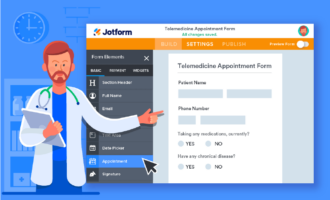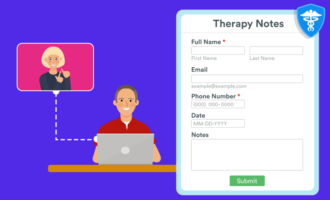To say that telehealth — the practice of using electronic communications and technology to provide health service — is booming would be an understatement. Even before the coronavirus pandemic hit, online searches for telemedicine and telehealth increased by about 25 percent in 2018 and 2019.
Of course, the COVID-19 situation caused a drastic increase. A recent survey revealed that the number of healthcare providers who have adopted technology and telemedicine to see patients increased from 22 percent in 2018 to 41 percent in March 2020. And 28 percent of practices surveyed reported that, in response to the pandemic, they had switched to providing healthcare visits only via telehealth.
You can start a telehealth program with a modest commitment and some careful planning. Once you’ve established your program, you can build on your initial services and create a more diverse array of options. Here’s what you can do to make your program a success.
How to build a telehealth program
- Have a plan
- Decide how you will use telehealth
- Involve your staff
- Learn about coverage
- Know the regulations
- Create an effective and convenient work environment
- Market your services
1. Have a plan
First, outline the measurable objectives of your telehealth program. What do you want to accomplish? Do you want to make your services more accessible? Do you want to add new patients?
Things to consider include how you want the program to affect things like revenue, patient retention, wait times, patient satisfaction, cancellations, staff efficiency, and any other measurements that will help your practice be more successful. Clearly defining your goals will help you decide who your optimum telehealth patients will be and what kinds of services to offer them.
2. Decide how you will use telehealth
There is no one-size-fits-all approach to telehealth, so be sure to clearly define how you’re going to tailor an approach that meets the needs of your practice. Maybe it makes sense for you to block off certain times during the week for telehealth visits, or it might be more effective to offer video visits during times that the office is traditionally closed. In other situations, it might be most effective to recommend a telehealth follow-up appointment for certain patients at the end of in-person visits.
3. Involve your staff
Getting your staff on board from the start will help them feel invested in the success of your telehealth program. Consider putting together a team that includes people who will be scheduling appointments, any IT staff, and people from other business functions that might be able to help you make the transition.
4. Learn about coverage
Before the COVID-19 pandemic hit, providers didn’t offer telehealth solutions because there was limited reimbursement from insurance providers as well as Medicaid and Medicare.
As a response to the growing pandemic, however, the Centers for Medicare and Medicaid Services (CMS) changed their requirements for reimbursements, allowing far more providers to offer telehealth programs to help decrease the spread of the virus and keep more patients safe.
It’s important for providers to familiarize themselves with the services that are covered so that they can plan their practice accordingly.
5. Know the regulations
Much like coverage, it’s important to know your state’s regulations for telehealth services. While some states may require you to have a preexisting relationship with the patient before you provide telehealth services, others may limit the location of the patients you treat. Regardless, you always have to be licensed in the patient’s state.
6. Create an effective and convenient work environment
Make sure the environment where you provide telehealth services is similar to a typical patient exam room. Pay attention to the unique needs of telehealth — such as appropriate lighting and sound — and ensure the room is quiet and conducive to patient privacy.
In addition, be sure that you’re using effective technology. That technology should be
- Easy for both staff and patients to use
- Safe, secure, and HIPAA-friendly
- Capable of integrating with your electronic health record (EHR) solution
7. Market your services
Once you have your telehealth program set up, it’s important to let your patients know that you’re offering those services. You can do this with signs posted in the physical office, announcements on your website, an email campaign, and in-person conversations. While not all patients will immediately embrace this approach, many will appreciate the additional options for seeing their healthcare provider.
How to use Jotform for your telehealth program
A successful telehealth program requires features that help with HIPAA compliance. You can easily create online medical forms that keep sensitive health data safe with Jotform. Our telemedicine toolkit helps practitioners
- Get patients’ electronic signatures
- Schedule patients online
- Collect file uploads
- Accept online payments
- Use conditional logic in their forms
- Add the Draw on Image widget to their forms for easier diagnosis
- Treat patients from any device
- Generate password-protected PDFs
In addition, online intake forms allow patients to fill out paperwork before a visit, giving telehealth providers information that’s crucial to treating patients remotely.
The future of telehealth programs
Even after the pandemic has passed, telehealth programs aren’t going away. By the end of 2020, 91 percent of employers are expected to offer these services, and the telemedicine industry is projected to reach $55.6 billion by 2025. Even that could be a conservative estimate, as some practices have already had a 50-percent increase in telehealth visits.
By planning ahead and taking the necessary steps to set the foundation for your telehealth program, your practice can reach more patients more effectively — now and in the post-COVID-19 future.

















































Send Comment:
2 Comments:
More than a year ago
I just want to thank you for posting this content I really find it useful. Please keep me posted for more updates.
More than a year ago
Great Article..!! Very Informative And Helpful..!! Thanks